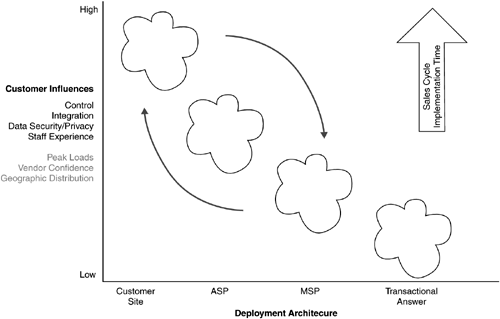Choosing a Software Deployment Architecture
| Figure 7-1 illustrates the rough relationships that exist between customers, corporate influences, and deployment architectures. It also captures the effects that one dimension often has on the others. For example, if your enterprise-class customer has a high need for integration with existing or legacy systems, wants more control over system operations, and is dealing with highly sensitive data, chances are good that they will favor a system that can be deployed at their site under the control of their MIS staff. Relaxing these constraints makes other deployment choices viable and in many cases even preferable. Figure 7-1. Choosing a deployment architecture I've intentionally simplified many of the variables that are associated with deployment architecture in the figure. For example, even if the customer has a high preference for deploying the system on site, they may still choose an ASP/MSP if the skills of their operational staff are insufficient or if the application's peak demands will exceed inhouse capabilities. The variables in blackcontrol, integration, and dataall share the same effect on the choice of deployment architecture (when high, deploy at the customer site). The variables in gray are on an opposite scalewhen high, deploy as an ASP, MSP, or Web service. The upper right corner of Figure 7-1 captures some of the corporate influences previously described. The figure also shows the migrations between various deployment options as light gray lines. |
EAN: N/A
Pages: 202
